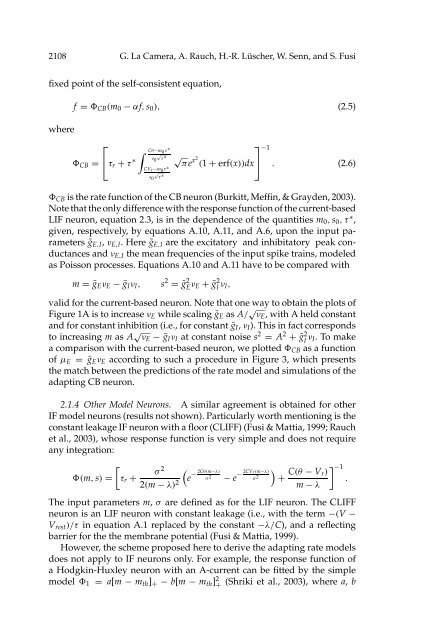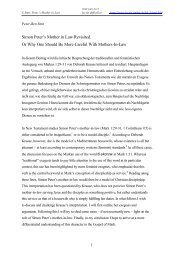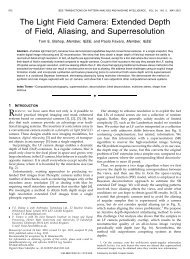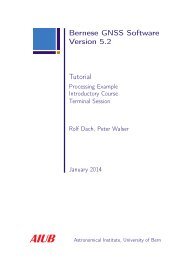Minimal Models of Adapted Neuronal Response to In Vivo–Like ...
Minimal Models of Adapted Neuronal Response to In Vivo–Like ...
Minimal Models of Adapted Neuronal Response to In Vivo–Like ...
You also want an ePaper? Increase the reach of your titles
YUMPU automatically turns print PDFs into web optimized ePapers that Google loves.
2108 G. La Camera, A. Rauch, H.-R. Lüscher, W. Senn, and S. Fusi<br />
fixed point <strong>of</strong> the self-consistent equation,<br />
where<br />
f = CB (m 0 − αf, s 0 ), (2.5)<br />
⎡<br />
⎤<br />
∫ Cθ−m 0 τ∗<br />
CB = ⎣τ r + τ ∗ √<br />
s 0 τ ∗ √ πe<br />
x 2 (1 + erf(x))dx⎦<br />
CVr−m 0 τ ∗<br />
s 0<br />
√<br />
τ ∗<br />
−1<br />
. (2.6)<br />
CB is the rate function <strong>of</strong> the CB neuron (Burkitt, Meffin, & Grayden, 2003).<br />
Note that the only difference with the response function <strong>of</strong> the current-based<br />
LIF neuron, equation 2.3, is in the dependence <strong>of</strong> the quantities m 0 , s 0 ,τ ∗ ,<br />
given, respectively, by equations A.10, A.11, and A.6, upon the input parameters<br />
ḡ E,I , ν E,I . Here ḡ E,I are the excita<strong>to</strong>ry and inhibita<strong>to</strong>ry peak conductances<br />
and ν E,I the mean frequencies <strong>of</strong> the input spike trains, modeled<br />
as Poisson processes. Equations A.10 and A.11 have <strong>to</strong> be compared with<br />
m = ḡ E ν E − ḡ I ν I , s 2 = ḡ 2 E ν E + ḡ 2 I ν I,<br />
valid for the current-based neuron. Note that one way <strong>to</strong> obtain the plots <strong>of</strong><br />
Figure 1A is <strong>to</strong> increase ν E while scaling ḡ E as A/ √ ν E , with A held constant<br />
and for constant inhibition (i.e., for constant ḡ I , ν I ). This in fact corresponds<br />
<strong>to</strong> increasing m as A √ ν E − ḡ I ν I at constant noise s 2 = A 2 + ḡ 2 I ν I. To make<br />
a comparison with the current-based neuron, we plotted CB as a function<br />
<strong>of</strong> µ E = ḡ E ν E according <strong>to</strong> such a procedure in Figure 3, which presents<br />
the match between the predictions <strong>of</strong> the rate model and simulations <strong>of</strong> the<br />
adapting CB neuron.<br />
2.1.4 Other Model Neurons. A similar agreement is obtained for other<br />
IF model neurons (results not shown). Particularly worth mentioning is the<br />
constant leakage IF neuron with a floor (CLIFF) (Fusi & Mattia, 1999; Rauch<br />
et al., 2003), whose response function is very simple and does not require<br />
any integration:<br />
[<br />
σ 2 (<br />
)<br />
(m, s) = τ r +<br />
2(m − λ) 2 e − 2Cθ(m−λ)<br />
σ 2 − e − 2CVr(m−λ)<br />
σ 2 + C(θ − V ] −1<br />
r)<br />
.<br />
m − λ<br />
The input parameters m, σ are defined as for the LIF neuron. The CLIFF<br />
neuron is an LIF neuron with constant leakage (i.e., with the term −(V −<br />
V rest )/τ in equation A.1 replaced by the constant −λ/C), and a reflecting<br />
barrier for the the membrane potential (Fusi & Mattia, 1999).<br />
However, the scheme proposed here <strong>to</strong> derive the adapting rate models<br />
does not apply <strong>to</strong> IF neurons only. For example, the response function <strong>of</strong><br />
a Hodgkin-Huxley neuron with an A-current can be fitted by the simple<br />
model 1 = a[m − m th ] + − b[m − m th ] 2 + (Shriki et al., 2003), where a, b
















